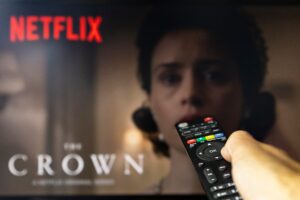
Netflix will finally reveal exactly how many people watch its programmes in the UK, giving an insight to the true cultural power of the streaming service and its impact on British viewing habits.
Until now it has been possible to know that 13 million people tuned in for the finale of the BBC’s Line of Duty or that 31 million viewers watched England in the Euro 2020 final – but Netflix has closely guarded the numbers of people who stream its hit shows such as Squid Game or Heartstopper.
In a change of direction, the streaming service agreed to sign up as a full member of the British ratings agency, Barb, meaning it will publish independently audited viewing figures that can be compared with traditional channels.
As a result, when the fifth series of The Crown is released next month, it will finally be possible to see whether the cultural coverage around Netflix’s royal show actually attracts more eyeballs than a less-hyped programme on a traditional television channel.
Preliminary figures from September showed how Netflix is already used by two-thirds of the British television viewing public in a given month. Netflix currently accounts for 8% of all television viewing in the UK, making the company larger than Channel 4, Channel 5, and Sky – but still far behind the BBC and ITV.
The decision to go public with viewing data for individual programmes suggests Netflix is confident that it will be seen in a good light. Reed Hastings, Netflix’s co-chief executive, said he was following up on a promise to the British television industry while speaking at a Royal Television Society event in 2019. “We’ve kept in touch with Barb since then and are pleased to make a commitment to its trusted measurement of how people watch television in the UK,” he said.
Netflix’s traditional hoarding of viewing data was long a bone of contention within the television industry, with the company selectively releasing viewing figures only when it suited the business. It would trumpet the tens of millions of people who had watched particular shows but used its own unusual definition of a viewer as someone who had watched just a few minutes of a programme. Rivals would often snark that the company never published the figures for its expensive flops, while programme creators could be unsure if their shows were being watched – or why they had been cancelled.
As a result the BBC’s former head of television strategy, Becky Marvell, warned in 2019 that traditional British broadcasters were “not competing on a level playing field”. She argued that the lack of Netflix viewing figures made it harder for show creators “to make the right decisions about who to work with”.
Netflix now believes that customers like to see what other people are watching and that it reinforces the company’s cultural standing. It has already introduced “top 10” viewing charts on its apps around the world, although the Barb deal makes the UK the first country in the world where Netflix has signed up to an independent ratings agency.
The company’s latest UK accounts showed it took £1.4bn in revenue from British customers, equivalent to almost 40% of the BBC’s licence fee income. However, subscriber numbers have started to plateau and it is planning to introduce a cheaper advertising-supported subscription.
Television ratings are calculated using a panel of tracking devices and data monitoring software installed in thousands of British homes. From these data points, estimates of television viewing are produced, such as the peak audience of 29 million people who tuned in to watch Queen Elizabeth’s funeral – or the 28,000 viewers who watched Monday’s night’s episode of Piers Morgan’s programme on talkTV.
Read more:
Netflix to reveal for first time how many people watch its shows in the UK






